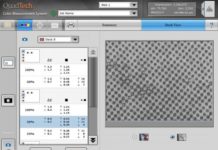QuadTech has introduced its Color Measurement System with SpectralCam HD, which aims to make off-line colour measurement of web-fed packaging film a thing of the past. The system provides film stabilisation and on-the-fly high-definition dot viewing.
The high-definition viewing capability facilitates easy on-the-fly detection of dot abnormalities such as pin-holing, bridging, doughnuts and halos. Images are captured at 2500dpi and made instantly accessible through the ICONTM user interface, so that dot quality detail can be analysed by the human eye as soon as ink is transferred to the substrate.
SpectralCam HD provides an instant means of identifying dot abnormalities that until now could only have been discovered by stopping production and analyzing a magnified sample of printed work offline. The operator has reassurance that dot abnormalities will be detected to a much higher standard than was previously possible, without compromising production up-time levels, said Laura Casale, project manager at QuadTech.
The enhanced viewing capability enables print operators to react faster to changes in pressure or plate anomalies and take appropriate remedial action in a shorter time, thereby reducing material waste and reject levels.
SpectralCam HD is likely to be of particular benefit in flexible packaging printing situations, where the ability to view dot profiles is paramount, and to operators of central impression-flexo presses, which require significant pressure adjustment. The device performs at up to 1067m/min (3500 ft/min) and is capable of working with a wide range of paper and film substrates.
Another innovation found in the Colour Measurement System is a web stabilizing unit that allows precise spectral colour measurement of transparent and opaque films on-the-fly without risk of substrate corrugation.
The web stabilizer device consists of a flat-top, low-friction platform, on to which the moving web is momentarily stabilized by suction, to enable colour measurement over two ceramic tiles: one black, to measure opacity, and one white, to measure transparency. The tiles meet the British Ceramic Research Association (BCRA) ceramic colour standard, guaranteeing a long-term constant backing value. The tile assembly is removable for easy cleaning.
The substrate is sucked into contact with the tile, in order to take colour readings without wrinkles, bubbles and shadows that may result in distortion. Suction occurs when a vacuum is created around the tiles, by pumping pulses of high-pressure air through a channel and out through small holes along the side of the tile. After being held for no more than the few milliseconds necessary to take a reading, the substrate is released. The low friction-coefficient of the contact area prevents scratching or scuffing of either the surface area or substrate. Multiple targets can be captured at one time.
The web stabiliser device provides an alternative to white rollers whose large surface areas are prone to contamination, difficult to clean, and fail to give a constant backing solution.
In package print, the need to measure colour off-line is a major barrier to achieving lean production management. The system empowers packaging printers to achieve optimum spectral colour quality without interruption to the printing run, whatever the substrate or application, and further drive waste out of the workflow, said Casale.



















